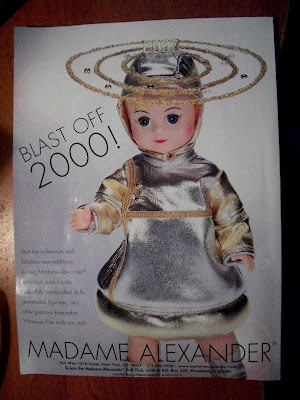Yes, it’s true:
I finally have the vaunted Millennium Beanie Baby! It cost $2.00 at the
Salvation Army Thrift Store on 87th and Cicero; astonishingly, it
still has its tag and the bow around its neck. You sometimes see them on eBay
for upwards of $25-30 depending on the condition.
Millennium is a small, magenta bear; on its chest, you
can see a symbol of Planet Earth with a sunrise next to it and “2000” on the
lower edge of the globe. Its ear-tag lists its birth date as January 1, 1999, which is interesting because it's the New Year's Day before the turn of the millennium. (I get the feeling that to be "born" on New Year's Day 2000 would have seemed a bit gauche.)
I find the combination of themes present in the overall bear unique. First, there’s the world globe, which I’ve
documented in several other items. This time, we have a new theme, that
of the morning sunrise, whose position behind the globe gives it an almost
halo-like effect. The addition of “2000” completes the image, but before I
summarize it, let me also state that the overall image is set diagonally and
flawlessly balanced on the bear’s leftmost side...exactly where the human heart
resides.
Its coloring carries
symbolic weight, too. Magenta is an offshoot of purple, a color that unites red
and blue. Besides being two out of three primary hues, red and blue represent
warm and cool. Interestingly enough, though blue and red are opposed, they are
not discordant in the same way that red and green are. Put those two side by
side, and it just looks bad.
Back to magenta. As I was
saying earlier, magenta is a slightly warmer offshoot of purple. Per Wikipedia,
purple symbolizes, among other things, individuality, unconventionality, and
uncertainty. These traits can be interpreted as negative, but magenta
represents their lighter, warmer, and more comforting side.
From all that,
the message is clear: The year 2000—and, by extension, the turn of the
millennium— will bring about love (the heart), harmony (the image’s perfect
balance), unity (the world globe) and a brand-new start (the morning sunrise).
It will be an uncertain time, but in the best and most hopeful way possible
(magenta).
Here is the
poem on its tag:
“A brand new
century has come to call/Health and happiness to one and all/Bring on the
fireworks and all the fun/Let’s keep the party going ‘til 2001!”
That last line
is a tongue-in-cheek jab at Prince’s song “1999:” “’Cause they say Two Thousand
zero-zero, party over, oops, outta time/So tonight I’m gonna party like it’s
1999.” The song itself has rather dark lyrics in spite of its catchy tune, and
the poem on the tag is the polar opposite of that: Far from being the end of
the world, 2000 is the start of something great!












